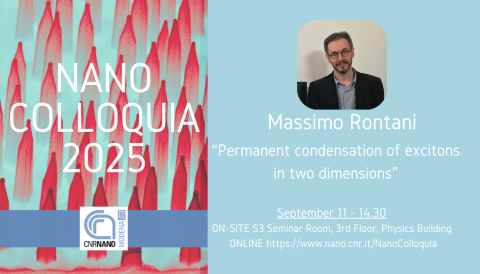
Speaker: Massimo Rontani - Cnr Nano
In this talk I will review our theoretical work on two-dimensional semimetals in the T′ phase, as possible hosts of the long-sought excitonic insulator phase [1-3]. These systems are major candidates in view of the enhanced electron-hole attraction due to reduced dimensionality, as confirmed by an increasing body of evidence [2,4]. Our approach relies on the integration of first-principles and model approaches. The former provides an accurate treatment of screening and gives full access to the exciton wave function and its energy spectrum. The latter, which builds on the ab-initio information, allows us to manage the coupled gap equations that control the stability and broken symmetry of the excitonic phase. These equations are complex, in view of the multiple degrees of freedom (spin and orbital) of excitons in monolayers and may hardly be treated in a black-box manner. I will specifically address the puzzle of monolayer WTe2 [2-4], whose many-body gap is thought to be sustained by excitons with finite momentum: While a charge density wave is expected, no one is detected. I will show how this behavior is related to the giant exchange interaction experienced by the bound electron-hole pairs [3]. Eventually, I will discuss the band structure of the excitonic insulator phase and predict how its peculiar fingerprints emerge in SdH oscillation and photoemission experiments.
References [1] D. Varsano, M. Palummo, E. Molinari, and M. Rontani. A monolayer transition-metal dichalcogenide as a topological excitonic insulator. Nature Nanotechnology 15, 367 (2020). [2] B. Sun, W. Zhao, T. Palomaki, Z. Fei, E. Runburg, P. Malinowski, X. Huang, J. Cenker, Y.-T. Cui, J.-H. Chu, X. Xu, S. Ataei, D. Varsano, M. Palummo, E. Molinari, M. Rontani, and D. Cobden. Evidence for equilibrium exciton condensation in monolayer WTe2. Nature Physics18, 94 (2022). [3] C. Cardoso et al., in preparation (2025). [4] Jia et al. Evidence for a monolayer excitonic insulator. Nature Physics 18, 87 (2022).